On October 27, 2020, the United States released the Invention of Artificial Intelligence: A Report on the Proliferation of ARTIFICIAL Intelligence Patents in the United States. The report breaks through traditional patent research methods and uses ARTIFICIAL intelligence to construct the patent landscape, providing an in-depth ysis of the development of ARTIFICIAL intelligence in the United States over the past four decades. It divided AI into eight sections and discussed machine learning one by one, improving accuracy and reducing costs. According to the report, artificial intelligence has made rapid progress in the LAST four decades in the United States, with the number of patent filings related to it rising, and ai technology spreading to a larger proportion of technology subcategories. More and more inventors, companies and other organizations are using ARTIFICIAL intelligence in their inventions and production processes. At the same time, AI technology is spreading more widely across U.S. states and counties. By comparing the data related to ARTIFICIAL intelligence in the United States with that in China, it can be found that China should not only learn the ysis method of patent landscape, but also strengthen the patent layout in the basic layer of ARTIFICIAL intelligence, narrow the gap of regional innovation ability, and improve the international competitiveness of enterprises' ARTIFICIAL intelligence patents.
1.1 Analysis of artificial intelligence development through patent landscape
1.2 Trends in the number of applications, the spread of AI across technology domains, across inventors and patent owners, and across geographies indicate the increasing importance of AI. Whether AI is as revolutionary as electricity or semiconductors depends in part on the ability of innovators and companies to successfully integrate AI inventions into existing and new products, processes and services. The report suggests that artificial intelligence has this potential.
1.3.1 Number of applications. An important sign of the value of a new technology is the increase in the number of patents filed, and AI patents have been on the rise for the past 40 years. Figure 1 shows the growth trend of open AI patent applications from 1976 to 2018 and its share in all open patent applications. Since AIPA was revised in late 1999 and during its implementation (gray fields in Figure 1), the information on trends since 2002 is more ytical. From 2002 to 2018, the number and share of ai patent applications generally increased. From 2002 to 2018, the annual number of applications for ARTIFICIAL intelligence patents doubled. While all PATENT filings at the USPTO increased during that period, ai's share of total patents also increased significantly, from 9 percent in 2002 to nearly 16 percent in 2018.
While the overall trend in AI patent filings has shown a dramatic increase, it does not reveal the nature of the AI involved. As mentioned earlier, a patent may belong to one or more of the eight technologies. For example, US patent No. 7392230 entitled "Liquid Machine for Physical Neural Networks utilizing Nanotechnology" is classified as machine learning and artificial intelligence hardware component technologies according to the above classification rules.
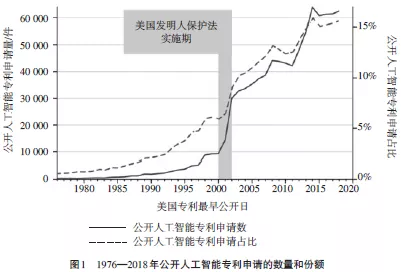
Picture 2 shows the number of published AI patent applications for each component technology from 1990 to 2018. From 2000 to 2002, the number of artificial intelligence patent applications for each component showed an increasing trend. However, there was a slight decline between 2007 and 2011. Planning control technology and knowledge processing technology remain in the top two spots, followed by artificial intelligence hardware and vision, followed by machine learning, natural language processing, speech and evolutionary computing.
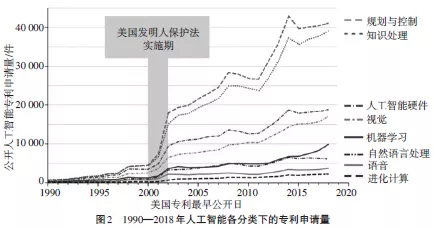
Picture 2 shows the number of published AI patent applications for each component technology from 1990 to 2018. From 2000 to 2002, the number of artificial intelligence patent applications for each component showed an increasing trend. However, there was a slight decline between 2007 and 2011. Planning control technology and knowledge processing technology remain in the top two spots, followed by artificial intelligence hardware and vision, followed by machine learning, natural language processing, speech and evolutionary computing.
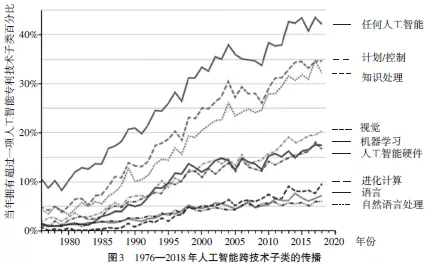
The AI component technology shows three different clusters with different diffusion rates. Four clusters are knowledge processing and planning control technologies, which spread quickly in the category of patented technologies. This status reflects the universal applicability of these AI components to a variety of technology domains. The proliferation of clusters (vision, machine learning, AI hardware) is slower but still increasing. The diffusion of the third cluster (evolutionary computing, speech and natural language processing) has been slower, hovering around 5% in the late 1990s, and only recently has it expanded to nearly 10% of all technology subcategories.
1.3.3 The spread of ARTIFICIAL intelligence between patent owners. Many inventors, companies and other organizations use ARTIFICIAL intelligence in their inventions and production processes. The increase in the percentage of inventors and organizations that receive AI patents each year is an important indicator of diffusion. This indicator can be calculated by using the names of the organizations and the names that appear on the licensed patents. However, using raw patent data can cause miscounts for and organizations because of variations in the way names are recorded. For example, "INTERNATIONAL Business Machines" and "International Business Machines Corporation" will be treated as two different organizations. To overcome this limitation it is necessary to rely again on the patent landscape, the numbers provided to and for organizations with patent names.
Figure 4 shows the annual growth trend of the percentage of ai-owning patentees in the total number of patentees and the percentage of ai-owning invention patentees in the total number of invention patentees in the United States from 1976 to 2018. The number of artificial intelligence invention patentees increased from 1 percent to 25 percent in 2018. In 2018, a quarter of all invention patentees used AI in their patents.
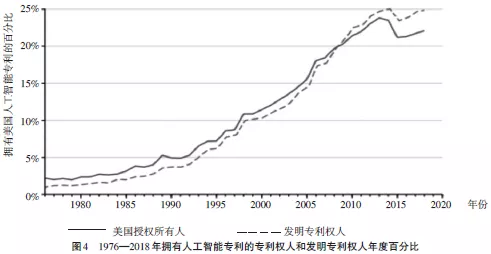
Table 1 shows the top 30 U.S. companies holding ai patents from 1976 to 2018. Among them, the top three companies have a wide gap in the number of AI patents held: IBM ranks first with 46,752 patents; Microsoft, with 22,067 patents; Google ranked third with 10,928 patents.
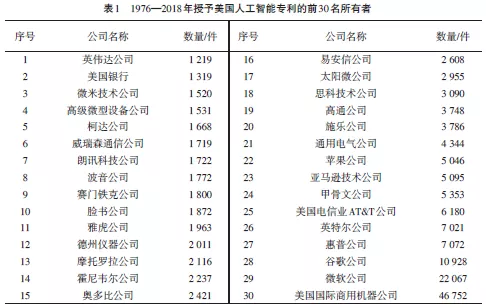
Table 1 shows the top 30 U.S. companies holding ai patents from 1976 to 2018. Among them, the top three companies have a wide gap in the number of AI patents held: IBM ranks first with 46,752 patents; Microsoft, with 22,067 patents; Google ranked third with 10,928 patents.
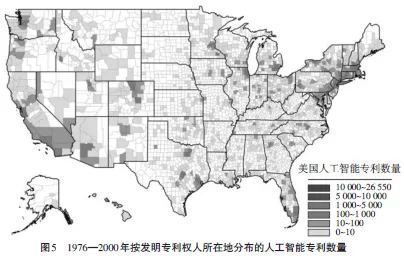
The location of the patentees of AI inventions since 2001 shows that AI technology has spread widely across states and counties in the United States (Figure 6). Maine and South Carolina, for example, are very active in digital data processing and business-specific data processing. The Oregon patents are mainly used in fitness training and equipment. In Montana, ARTIFICIAL intelligence is incorporated into inventions that yze the chemical and physical properties of materials. The Midwest is also adopting AI, albeit in much aller numbers, but its patentees are working on ai for digital information tranission, image processing, and data recognition and presentation. Wisconsin was followed by Ohio and Kansas in medical devices and diagnostic, surgical and accreditation procedures. In Iowa, Kansas, Missouri, Nebraska and Ohio, ARTIFICIAL intelligence technology is contributing to the invention of telephone communications. And artificial intelligence for agriculture-related applications is a focus in North Dakota. For example, artificial intelligence can be used to image crop samples to identify individual grains and determine if they are intact.
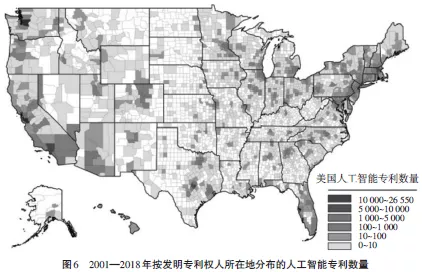
02
Evaluation of the report
2.1 Distribution of artificial intelligence patent technology in the United States
Ai hardware (processor/chip), machine learning technologies, natural language processing and computer vision technologies are the leading areas of AI innovation in the US. However, despite the rapid development of speech recognition technology, natural language processing technology and feature recognition products, the United States is inferior in six areas of deep learning, knowledge mapping products, computer vision products, intelligent delivery, intelligent robots and intelligent devices. According to the division of artificial intelligence industry level and industry field, the development area of ARTIFICIAL intelligence in the United States is mainly in the basic layer and the technology layer, and the distribution in the application layer is less. The basic layer is the field with high capital consumption and high development potential, which can provide basic background guarantee for the realization of ARTIFICIAL intelligence technology and the landing of artificial intelligence application. This distribution shows the huge investment and development potential in AI in the United States (Table 2).

2.2 Correlation of ARTIFICIAL intelligence patent field in the United States
It is worth noting that the US study also shows technological relevance. Speaking of key technology areas, artificial intelligence patents in image recognition, machine learning and deep learning have increased significantly in the US since 2012. AlexNet was part of ImageNet's massive visual recognition challenge in 2010 and a watershed that changed the technological trajectory of image recognition and machine learning. Patent applications for artificial intelligence hardware, including computer processor accelerators and dedicated memory, have increased along with computer vision. The close connection between applications in both technologies reflects the interplay between aances in image recognition and the need for computing power and performance. The cooperation between planning control technology and knowledge processing technology also promotes the development of knowledge processing technology. Machine learning, natural language processing, speech and evolutionary computing are developing in a cluster. It can be seen that the combination of machine learning technology and evolutionary computing contributes to the development of natural language processing and speech.
2.3 Main applicants for ARTIFICIAL intelligence patents in the United States
From the field layout of artificial intelligence patents, the invention of US enterprises in information and communication technology has a strong momentum from 1967 to 2018. The report shows that from 1976 to 2018, the top 30 US companies holding AI patents held 29 percent of all AI patents, with most of the top 30 companies in information and communication technology. Such as IBM, Google, Intel, Oracle, Apple, Facebook, Verizon communications, Microsoft, HP, Lucent Technologies and so on. But there are notable exceptions, such as General Electric, Boeing and Bank of America. In recent years, GE has insisted on developing ai industry in manufacturing, integrating AI technology into the manufacture of mechanical products.
The number of patent applications of large American companies is huge, leading the world, showing a development trend of "large companies, leading". Using the De Winter Innovation Index database to search ai patents, it was found that the top five companies in total AI patents -- IBM, Microsoft, Google and Intel, excluding HP -- from 2016 to 2020. It is also a member of the world's top 15 institutions in terms of total patents in the field of artificial intelligence from 2016 to 2020. It is worth emphasizing that from 2016 to 2020, The total amount of AI patents issued by Microsoft and IBM not only occupied the top two in the US, but also the top two in the world.
In terms of research and development activity from 2016 to 2020, large US enterprises have been highly active in the field of ARTIFICIAL intelligence. By yzing the R&D activity of major countries/organizations in the field of artificial intelligence, it can be found that from 2016 to 2020, Intel corporation, Google Corporation and INTERNATIONAL Business Machines Corporation (IBM) ranked third and fifth among the top five in the r&d activity of artificial intelligence patents. The United States occupies five of the top 15 spots (table 3). It can be seen that THE OVERALL RESEARCH and development activity of American enterprises is at the forefront of the world. The number of AI patents of American companies is not only huge, but will continue to increase in the future due to superior r&d aantages.
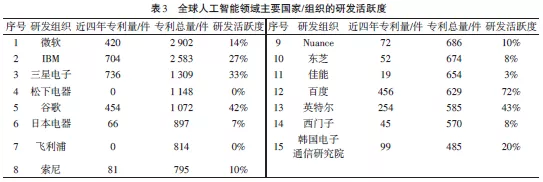
2.4 Regional distribution of ARTIFICIAL intelligence inventions in the United States
The geographical distribution of patent applications in the United States can be extracted from the report. ① Universality. From 1976 to 2018, the level of AI development in every state in the United States increased steadily and was widely distributed. ② Differences. Each state in the United States has developed a unique aantage in business data processing, fitness equipment, chemical and physical properties ysis of materials, medical diagnosis and surgery, telephone communications and other fields. (3) central radiation. Ai invention patentees tend to be concentrated in larger cities and established technology hubs, such as California's Silicon Valley. These locations have the resource aantage of making it easier to apply AI. Technology centers, for example, are already home to successful companies whose employees have the expertise needed to understand and implement AI technologies. This aantage also extends to regions with major research universities.
2.4 Regional distribution of ARTIFICIAL intelligence inventions in the United States
The geographical distribution of patent applications in the United States can be extracted from the report. ① Universality. From 1976 to 2018, the level of AI development in every state in the United States increased steadily and was widely distributed. ② Differences. Each state in the United States has developed a unique aantage in business data processing, fitness equipment, chemical and physical properties ysis of materials, medical diagnosis and surgery, telephone communications and other fields. (3) central radiation. Ai invention patentees tend to be concentrated in larger cities and established technology hubs, such as California's Silicon Valley. These locations have the resource aantage of making it easier to apply AI. Technology centers, for example, are already home to successful companies whose employees have the expertise needed to understand and implement AI technologies. This aantage also extends to regions with major research universities.
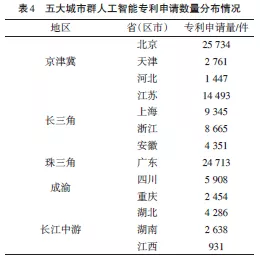
It can be seen that different regions have different development trends and characteristics, and the Chinese government should guide enterprises to develop ARTIFICIAL intelligence in different fields according to the aantages of local industries. But at the same time, we should also pay attention to the coordinated development of regions to avoid large innovation capacity gap.
04
conclusion
Artificial intelligence patents show a rapid development trend, countries have formulated the development strategy of artificial intelligence, and the relevant situation of artificial intelligence research. China has also enacted relevant policies, such as Made in China 2025 and The Development Plan for the Next generation of ARTIFICIAL Intelligence, to promote technological innovation and industrial development. Artificial intelligence has developed into a strategic industrial technology and become the core technology of the new generation of industrial transformation. Who can occupy the position of technology in the era of artificial intelligence, who will be able to occupy a powerful position in international competition, and can dominate the formulation of global technology standardization. The United States has been China's strategic partner for a long time and has occupied the technological high ground in the field of artificial intelligence for a long time. The development status and trends of ARTIFICIAL intelligence in the United States are the focus of countries around the world. Recently, the United States released the Artificial Intelligence Inventions: A Report on the Proliferation of ARTIFICIAL Intelligence Patents in the United States, which provides the basic status of artificial intelligence patent applications from the perspective of the United States.
Comparing this situation with the development status of Artificial intelligence patents in China, it can be found that the ysis tools of Artificial intelligence patents in China are relatively basic, which not only restricts the ysis of artificial intelligence technology and makes it lag behind that of developed countries, but also affects the ysis of artificial intelligence in China in the long run. The lack of investment in artificial intelligence in China makes the basic layer unable to research and develop, such as the fatal problem of low autonomy in chip research and development, resulting in the industrial development problem of weak output of the application layer. Technological monopoly makes the overall RESEARCH and development of ARTIFICIAL intelligence less active, and all companies find it difficult to develop because of the technological threshold; The uneven development level of artificial intelligence in different regions of China leads to a significant regional gap in ARTIFICIAL intelligence. The southeast coast, Beijing, Shanghai and Guangzhou have aantages in the field of ARTIFICIAL intelligence, but it is difficult to popularize this aantage to the whole country. In the future development, China should update patent ysis tools to avoid affecting patent layout due to backward ysis methods, and should always maintain the technological aantages in the application layer and develop artificial intelligence patents at the base layer, so as to constantly strengthen the development of artificial intelligence patents. At the same time, China should also develop artificial intelligence industry according to local conditions and reduce the regional gap and industry gap.